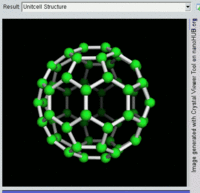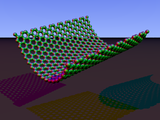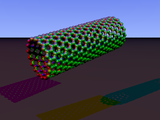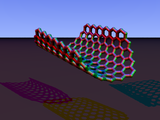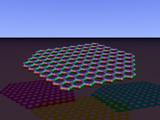Nanomaterials describe, in principle, materials of which a single unit is sized (in at least one dimension) between 1 to 1000 nanometres (10−9 meter) but usually is 1 to 100 nm (the usual definition of nanoscale[1]).
Nanomaterials research takes a materials science-based approach to nanotechnology, leveraging advances in materials metrology and synthesis which have been developed in support of microfabrication research. Materials with structure at the nanoscale often have unique optical, electronic, or mechanical properties.[2]
Nanomaterials are slowly becoming commercialized[3] and beginning to emerge as commodities.[4]
Definition
There are significant differences among agencies on the definition of a nanomaterial.[5]In ISO/TS 80004, nanomaterial is defined as a "material with any external dimension in the nanoscale or having internal structure or surface structure in the nanoscale", with nanoscale defined as the "length range approximately from 1 nm to 100 nm". This includes both nano-objects, which are discrete pieces of material, and nanostructured materials, which have internal or surface structure on the nanoscale; a nanomaterial may be a member of both these categories.[6]
On 18 October 2011, the European Commission adopted the following definition of a nanomaterial: "A natural, incidental or manufactured material containing particles, in an unbound state or as an aggregate or as an agglomerate and for 50% or more of the particles in the number size distribution, one or more external dimensions is in the size range 1 nm – 100 nm. In specific cases and where warranted by concerns for the environment, health, safety or competitiveness the number size distribution threshold of 50% may be replaced by a threshold between 1% to 50%."[7]
Sources
Engineered
Engineered nanomaterials have been deliberately engineered and manufactured by humans to have certain required properties.[8]Legacy nanomaterials are those that were in commercial production prior to the development of nanotechnology as incremental advancements over other colloidal or particulate materials.[9][10][11] They include carbon black and titanium dioxide nanoparticles.[12]
Incidental
Nanomaterials may be incidentally produced as a byproduct of mechanical or industrial processes.Sources of incidental nanoparticles include vehicle engine exhausts, welding fumes, combustion processes from domestic solid fuel heating and cooking. Incidental atmospheric nanoparticles are often referred to as ultrafine particles, and are a contributor to air pollution.[13]Natural
Biological systems often feature natural, functional nanomaterials. The structure of foraminifera (mainly chalk) and viruses (protein, capsid), the wax crystals covering a lotus or nasturtium leaf, spider and spider-mite silk,[14] the blue hue of tarantulas,[15] the "spatulae" on the bottom of gecko feet, some butterfly wing scales, natural colloids (milk, blood), horny materials (skin, claws, beaks, feathers, horns, hair), paper, cotton, nacre, corals, and even our own bone matrix are all natural organic nanomaterials.Natural inorganic nanomaterials occur through crystal growth in the diverse chemical conditions of the Earth's crust. For example, clays display complex nanostructures due to anisotropy of their underlying crystal structure, and volcanic activity can give rise to opals, which are an instance of a naturally occurring photonic crystals due to their nanoscale structure. Fires represent particularly complex reactions and can produce pigments, cement, fumed silica etc.
Natural sources of nanoparticles include combustion products forest fires, volcanic ash, ocean spray, and the radioactive decay of radon gas. Natural nanomaterials can also be formed through weathering processes of metal- or anion-containing rocks, as well as at acid mine drainage sites.[13]
- Gallery of natural nanomaterials
-
Viral capsid
-
"Lotus effect", hydrophobic effect with self-cleaning ability
-
Blue hue of a species of tarantula (450 nm ± 20 nm)
Types
Nano-objects are often categorized as to how many of their dimensions fall in the nanoscale. A nanoparticle is defined a nano-object with all three external dimensions in the nanoscale, whose longest and the shortest axes do not differ significantly. A nanofiber has two external dimensions in the nanoscale, with nanotubes being hollow nanofibers and nanorods being solid nanofibers. A nanoplate has one external dimension in the nanoscale, and if the two larger dimensions are significantly different it is called a nanoribbon. For nanofibers and nanoplates, the other dimensions may or may not be in the nanoscale, but must be significantly larger. A significant different in all cases is noted to be typically at least a factor of 3.[16]Nanostructured materials are often categorized by what phases of matter the contain. A nanocomposite is a solid containing at least one physically or chemically distinct region, or collection of regions, having at least one dimension in the nanoscale.. A nanofoam has a liquid or solid matrix, filled with a gaseous phase, where either phase has dimensions on the nanoscale. A nanoporous material is a solid material containing nanopores, cavities with dimensions on the nanoscale. A nanocrystalline material has a significant fraction of crystal grains in the nanoscale.[17]
The above definitions are all according to ISO/TS 80004. In other sources, nanoporous materials and nanofoam are sometimes considered nanostructures but not nanomaterials because only the voids and not the materials themselves are nanoscale.[18] Although the ISO definition only considers round nano-objects to be nanoparticles, other sources use the term nanoparticle for all shapes.[19]
Nanoparticles
Nanoparticles have all three dimensions on the nanoscale. Nanoparticles can also be embedded in a bulk solid to form a nanocomposite.[18]Fullerenes
The fullerenes are a class of allotropes of carbon which conceptually are graphene sheets rolled into tubes or spheres. These include the carbon nanotubes (or silicon nanotubes) which are of interest both because of their mechanical strength and also because of their electrical properties.[20]
Rotating view of C60, one kind of fullerene.
The first fullerene molecule to be discovered, and the family's namesake, buckminsterfullerene (C60), was prepared in 1985 by Richard Smalley, Robert Curl, James Heath, Sean O'Brien, and Harold Kroto at Rice University. The name was a homage to Buckminster Fuller, whose geodesic domes it resembles. Fullerenes have since been found to occur in nature.[21] More recently, fullerenes have been detected in outer space.[22]
For the past decade, the chemical and physical properties of fullerenes have been a hot topic in the field of research and development, and are likely to continue to be for a long time. In April 2003, fullerenes were under study for potential medicinal use: binding specific antibiotics to the structure of resistant bacteria and even target certain types of cancer cells such as melanoma. The October 2005 issue of Chemistry and Biology contains an article describing the use of fullerenes as light-activated antimicrobial agents. In the field of nanotechnology, heat resistance and superconductivity are among the properties attracting intense research.
A common method used to produce fullerenes is to send a large current between two nearby graphite electrodes in an inert atmosphere. The resulting carbon plasma arc between the electrodes cools into sooty residue from which many fullerenes can be isolated.
There are many calculations that have been done using ab-initio Quantum Methods applied to fullerenes. By DFT and TDDFT methods one can obtain IR, Raman and UV spectra. Results of such calculations can be compared with experimental results.
Metal-based nanoparticles
Inorganic nanomaterials, (e.g. quantum dots, nanowires and nanorods) because of their interesting optical and electrical properties, could be used in optoelectronics.[23] Furthermore, the optical and electronic properties of nanomaterials which depend on their size and shape can be tuned via synthetic techniques. There are the possibilities to use those materials in organic material based optoelectronic devices such as Organic solar cells, OLEDs etc. The operating principles of such devices are governed by photoinduced processes like electron transfer and energy transfer. The performance of the devices depends on the efficiency of the photoinduced process responsible for their functioning. Therefore, better understanding of those photoinduced processes in organic/inorganic nanomaterial composite systems is necessary in order to use them in optoelectronic devices.Nanoparticles or nanocrystals made of metals, semiconductors, or oxides are of particular interest for their mechanical, electrical, magnetic, optical, chemical and other properties.[24][25] Nanoparticles have been used as quantum dots and as chemical catalysts such as nanomaterial-based catalysts. Recently, a range of nanoparticles are extensively investigated for biomedical applications including tissue engineering, drug delivery, biosensor.[26] [27]
Nanoparticles are of great scientific interest as they are effectively a bridge between bulk materials and atomic or molecular structures. A bulk material should have constant physical properties regardless of its size, but at the nano-scale this is often not the case. Size-dependent properties are observed such as quantum confinement in semiconductor particles, surface plasmon resonance in some metal particles and superparamagnetism in magnetic materials.
Nanoparticles exhibit a number of special properties relative to bulk material. For example, the bending of bulk copper (wire, ribbon, etc.) occurs with movement of copper atoms/clusters at about the 50 nm scale. Copper nanoparticles smaller than 50 nm are considered super hard materials that do not exhibit the same malleability and ductility as bulk copper. The change in properties is not always desirable. Ferroelectric materials smaller than 10 nm can switch their magnetisation direction using room temperature thermal energy, thus making them useless for memory storage. Suspensions of nanoparticles are possible because the interaction of the particle surface with the solvent is strong enough to overcome differences in density, which usually result in a material either sinking or floating in a liquid. Nanoparticles often have unexpected visual properties because they are small enough to confine their electrons and produce quantum effects. For example, gold nanoparticles appear deep red to black in solution.
The often very high surface area to volume ratio of nanoparticles provides a tremendous driving force for diffusion, especially at elevated temperatures. Sintering is possible at lower temperatures and over shorter durations than for larger particles. This theoretically does not affect the density of the final product, though flow difficulties and the tendency of nanoparticles to agglomerate do complicate matters. The surface effects of nanoparticles also reduces the incipient melting temperature.
One-dimensional nanostructures
The smallest possible crystalline wires with cross-section as small as a single atom can be engineered in cylindrical confinement [28][29][30]. Carbon nanotubes, a natural semi-1D nanostructure, can be used as a template for synthesis. Confinement provides mechanical stabilization and prevents linear atomic chains from disintegration; other structures of 1D nanowires are predicted to be mechanically stable even upon isolation from the templates [31][32].Two-dimensional nanostructures
2D materials are crystalline materials consisting of a two-dimensional single layer of atoms. The most important representative graphene was discovered in 2004.Box-shaped graphene (BSG) nanostructure is an example of 3D nanomaterial.[33] BSG nanostructure has appeared after mechanical cleavage of pyrolytic graphite. This nanostructure is a multilayer system of parallel hollow nanochannels located along the surface and having quadrangular cross-section. The thickness of the channel walls is approximately equal to 1 nm. The typical width of channel facets makes about 25 nm.
Thin films with nanoscale thicknesses are considered nanostructures, but are sometimes not considered nanomaterials because they do not exist separately from the substrate.[18]
Bulk nanostructured materials
Some bulk materials contain features on the nanoscale, including nanocomposites, nanocrystalline materials, nanostructured films, and nanotextured surfaces.[18]Applications
Nano materials are used in a variety of, manufacturing processes, products and healthcare including paints, filters, insulation and lubricant additives. In healthcare Nanozymes are nanomaterials with enzyme-like characteristics.[34] They are an emerging type of artificial enzyme, which have been used for wide applications in such as biosensing, bioimaging, tumor diagnosis,[35] antibiofouling and more. In paints nanomaterials are used to improve UV protection and improve ease of cleaning.[36] High quality filters may be produced using nanostructures, these filters are capable of removing particulate as small as a virus as seen in a water filter created by Seldon Technologies. In the air purification field, nano technology was used to combat the spread of MERS in Saudi Arabian hospitals in 2012.[37] Nanomaterials are being used in modern and human-safe insulation technologies, in the past they were found in Asbestos-based insulation.[38] As a lubricant additive, nano materials have the ability to reduce friction in moving parts. Worn and corroded parts can also be repaired with self-assembling anisotropic nanoparticles called TriboTEX.[37]Synthesis
The goal of any synthetic method for nanomaterials is to yield a material that exhibits properties that are a result of their characteristic length scale being in the nanometer range (1 – 100 nm).Accordingly, the synthetic method should exhibit control of size in this range so that one property or another can be attained. Often the methods are divided into two main types "Bottom Up" and "Top Down."
Bottom up methods
Bottom up methods involve the assembly of atoms or molecules into nanostructured arrays. In these methods the raw material sources can be in the form of gases, liquids or solids. The latter requiring some sort of disassembly prior to their incorporation onto a nanostructure. Bottom methods generally fall into two categories: chaotic and controlled.Chaotic processes involve elevating the constituent atoms or molecules to a chaotic state and then suddenly changing the conditions so as to make that state unstable. Through the clever manipulation of any number of parameters, products form largely as a result of the insuring kinetics. The collapse from the chaotic state can be difficult or impossible to control and so ensemble statistics often govern the resulting size distribution and average size. Accordingly, nanoparticle formation is controlled through manipulation of the end state of the products. Examples of Chaotic Processes are: Laser ablation, Exploding wire, Arc, Flame pyrolysis, Combustion, Precipitation synthesis techniques.
Controlled Processes involve the controlled delivery of the constituent atoms or molecules to the site(s) of nanoparticle formation such that the nanoparticle can grow to a prescribed sizes in a controlled manner. Generally the state of the constituent atoms or molecules are never far from that needed for nanoparticle formation. Accordingly, nanoparticle formation is controlled through the control of the state of the reactants. Examples of controlled processes are self-limiting growth solution, self-limited chemical vapor deposition, shaped pulse femtosecond laser techniques, and molecular beam epitaxy.
Characterization
Novel effects can occur in materials when structures are formed with sizes comparable to any one of many possible length scales, such as the de Broglie wavelength of electrons, or the optical wavelengths of high energy photons. In these cases quantum mechanical effects can dominate material properties. One example is quantum confinement where the electronic properties of solids are altered with great reductions in particle size. The optical properties of nanoparticles, e.g. fluorescence, also become a function of the particle diameter. This effect does not come into play by going from macrosocopic to micrometer dimensions, but becomes pronounced when the nanometer scale is reached.In addition to optical and electronic properties, the novel mechanical properties of many nanomaterials is the subject of nanomechanics research. When added to a bulk material, nanoparticles can strongly influence the mechanical properties of the material, such as the stiffness or elasticity. For example, traditional polymers can be reinforced by nanoparticles (such as carbon nanotubes) resulting in novel materials which can be used as lightweight replacements for metals. Such composite materials may enable a weight reduction accompanied by an increase in stability and improved functionality.[39]
Finally, nanostructured materials with small particle size such as zeolites, and asbestos, are used as catalysts in a wide range of critical industrial chemical reactions. The further development of such catalysts can form the basis of more efficient, environmentally friendly chemical processes.
The first observations and size measurements of nano-particles were made during the first decade of the 20th century. Zsigmondy made detailed studies of gold sols and other nanomaterials with sizes down to 10 nm and less. He published a book in 1914.[40] He used an ultramicroscope that employs a dark field method for seeing particles with sizes much less than light wavelength.
There are traditional techniques developed during 20th century in Interface and Colloid Science for characterizing nanomaterials. These are widely used for first generation passive nanomaterials specified in the next section.
These methods include several different techniques for characterizing particle size distribution. This characterization is imperative because many materials that are expected to be nano-sized are actually aggregated in solutions. Some of methods are based on light scattering. Others apply ultrasound, such as ultrasound attenuation spectroscopy for testing concentrated nano-dispersions and microemulsions.[41]
There is also a group of traditional techniques for characterizing surface charge or zeta potential of nano-particles in solutions. This information is required for proper system stabilzation, preventing its aggregation or flocculation. These methods include microelectrophoresis, electrophoretic light scattering and electroacoustics. The last one, for instance colloid vibration current method is suitable for characterizing concentrated systems.
Uniformity
The chemical processing and synthesis of high performance technological components for the private, industrial and military sectors requires the use of high purity ceramics, polymers, glass-ceramics and material composites. In condensed bodies formed from fine powders, the irregular sizes and shapes of nanoparticles in a typical powder often lead to non-uniform packing morphologies that result in packing density variations in the powder compact.Uncontrolled agglomeration of powders due to attractive van der Waals forces can also give rise to in microstructural inhomogeneities. Differential stresses that develop as a result of non-uniform drying shrinkage are directly related to the rate at which the solvent can be removed, and thus highly dependent upon the distribution of porosity. Such stresses have been associated with a plastic-to-brittle transition in consolidated bodies, and can yield to crack propagation in the unfired body if not relieved.[42][43] [44]
In addition, any fluctuations in packing density in the compact as it is prepared for the kiln are often amplified during the sintering process, yielding inhomogeneous densification. Some pores and other structural defects associated with density variations have been shown to play a detrimental role in the sintering process by growing and thus limiting end-point densities. Differential stresses arising from inhomogeneous densification have also been shown to result in the propagation of internal cracks, thus becoming the strength-controlling flaws. [45][46]
It would therefore appear desirable to process a material in such a way that it is physically uniform with regard to the distribution of components and porosity, rather than using particle size distributions which will maximize the green density. The containment of a uniformly dispersed assembly of strongly interacting particles in suspension requires total control over particle-particle interactions. It should be noted here that a number of dispersants such as ammonium citrate (aqueous) and imidazoline or oleyl alcohol (nonaqueous) are promising solutions as possible additives for enhanced dispersion and deagglomeration. Monodisperse nanoparticles and colloids provide this potential.[47]
Monodisperse powders of colloidal silica, for example, may therefore be stabilized sufficiently to ensure a high degree of order in the colloidal crystal or polycrystalline colloidal solid which results from aggregation. The degree of order appears to be limited by the time and space allowed for longer-range correlations to be established. Such defective polycrystalline colloidal structures would appear to be the basic elements of sub-micrometer colloidal materials science, and, therefore, provide the first step in developing a more rigorous understanding of the mechanisms involved in microstructural evolution in high performance materials and components.
Health and safety
World Health Organization guidelines
The World Health Organization (WHO) published a guideline on protecting workers from potential risk of manufactured nanomaterials at the end of 2017.[50] WHO used a precautionary approach as one of its guiding principles. This means that exposure has to be reduced, despite uncertainty about the adverse health effects, when there are reasonable indications to do so. In addition, the hierarchy of controls was an important guiding principle. This means that when there is a choice between control measures, those measures that are closer to the root of the problem should always be preferred over measures that put a greater burden on workers, such as the use of personal protective equipment (PPE). WHO commissioned systematic reviews for all important issues to assess the current state of the science and to inform the recommendations according to the process set out in the WHO Handbook for guideline development. The recommendations were rated as “strong” or “conditional” depending on the quality of the scientific evidence, values and preferences, and costs related to the recommendation.The WHO guidelines contain the following recommendations for safe handling of MNMs:
A. Assess health hazards of MNMs
- WHO recommends assigning hazard classes to all MNMs according to the Globally Harmonized System (GHS) of Classification and Labelling of Chemicals for use in safety data sheets. For a limited number of MNMs this information is made available in the guidelines (strong recommendation, moderate-quality evidence).
- WHO recommends updating safety data sheets with MNM-specific hazard information or indicating which toxicological end-points did not have adequate testing available (strong recommendation, moderate-quality evidence).
- For the respirable fibres and granular biopersistent particles’ groups, the GDG suggests using the available classification of MNMs for provisional classification of nanomaterials of the same group (conditional recommendation, low-quality evidence).
- WHO suggests assessing workers’ exposure in workplaces with methods similar to those used for the proposed specific occupational exposure limit (OEL) value of the MNM (conditional recommendation, low-quality evidence).
- Because there are no specific regulatory OEL values for MNMs in workplaces, WHO suggests assessing whether workplace exposure exceeds a proposed OEL value for the MNM. A list of proposed OEL values is provided in an annex of the guidelines. The chosen OEL should be at least as protective as a legally mandated OEL for the bulk form of the material (conditional recommendation, low-quality evidence).
- If specific OELs for MNMs are not available in workplaces, WHO suggests a step-wise approach for inhalation exposure with, first an assessment of the potential for exposure; second, conducting basic exposure assessment and third, conducting a comprehensive exposure assessment such as those proposed by the Organisation for Economic Cooperation and Development (OECD) or Comité Européen de Normalisation (the European Committee for Standardization, CEN) (conditional recommendation, moderate quality evidence).
- For dermal exposure assessment, WHO found that there was insufficient evidence to recommend one method of dermal exposure assessment over another.
- Based on a precautionary approach, WHO recommends focusing control of exposure on preventing inhalation exposure with the aim of reducing it as much as possible (strong recommendation, moderate-quality evidence).
- WHO recommends reduction of exposures to a range of MNMs that have been consistently measured in workplaces especially during cleaning and maintenance, collecting material from reaction vessels and feeding MNMs into the production process. In the absence of toxicological information, WHO recommends implementing the highest level of controls to prevent workers from any exposure. When more information is available, WHO recommends taking a more tailored approach (strong recommendation, moderate-quality evidence).
- WHO recommends taking control measures based on the principle of hierarchy of controls, meaning that the first control measure should be to eliminate the source of exposure before implementing control measures that are more dependent on worker involvement, with PPE being used only as a last resort. According to this principle, engineering controls should be used when there is a high level of inhalation exposure or when there is no, or very little, toxicological information available. In the absence of appropriate engineering controls PPE should be used, especially respiratory protection, as part of a respiratory protection programme that includes fit-testing (strong recommendation, moderate-quality evidence).
- WHO suggests preventing dermal exposure by occupational hygiene measures such as surface cleaning, and the use of appropriate gloves (conditional recommendation, low quality evidence).
- When assessment and measurement by a workplace safety expert is not available, WHO suggests using control banding for nanomaterials to select exposure control measures in the workplace. Owing to a lack of studies, WHO cannot recommend one method of control banding over another (conditional recommendation, very low-quality evidence).
Other guidance
Because nanotechnology is a recent development, the health and safety effects of exposures to nanomaterials, and what levels of exposure may be acceptable, are subjects of ongoing research.[8] Of the possible hazards, inhalation exposure appears to present the most concern. Animal studies indicate that carbon nanotubes and carbon nanofibers can cause pulmonary effects including inflammation, granulomas, and pulmonary fibrosis, which were of similar or greater potency when compared with other known fibrogenic materials such as silica, asbestos, and ultrafine carbon black. Although the extent to which animal data may predict clinically significant lung effects in workers is not known, the toxicity seen in the short-term animal studies indicate a need for protective action for workers exposed to these nanomaterials, although no reports of actual adverse health effects in workers using or producing these nanomaterials were known as of 2013.[51] Additional concerns include skin contact and ingestion exposure,[51][52][53] and dust explosion hazards.[54][55]Elimination and substitution are the most desirable approaches to hazard control. While the nanomaterials themselves often cannot be eliminated or substituted with conventional materials,[8] it may be possible to choose properties of the nanoparticle such as size, shape, functionalization, surface charge, solubility, agglomeration, and aggregation state to improve their toxicological properties while retaining the desired functionality.[56] Handling procedures can also be improved, for example, using a nanomaterial slurry or suspension in a liquid solvent instead of a dry powder will reduce dust exposure.[8] Engineering controls are physical changes to the workplace that isolate workers from hazards, mainly ventilation systems such as fume hoods, gloveboxes, biosafety cabinets, and vented balance enclosures.[57] Administrative controls are changes to workers' behavior to mitigate a hazard, including training on best practices for safe handling, storage, and disposal of nanomaterials, proper awareness of hazards through labeling and warning signage, and encouraging a general safety culture. Personal protective equipment must be worn on the worker's body and is the least desirable option for controlling hazards.[8] Personal protective equipment normally used for typical chemicals are also appropriate for nanomaterials, including long pants, long-sleeve shirts, and closed-toed shoes, and the use of safety gloves, goggles, and impervious laboratory coats.[57] In some circumstances respirators may be used.[56]
Exposure assessment is a set of methods used to monitor contaminant release and exposures to workers. These methods include personal sampling, where samplers are located in the personal breathing zone of the worker, often attached to a shirt collar to be as close to the nose and mouth as possible; and area/background sampling, where they are placed at static locations. The assessment should use both particle counters, which monitor the real-time quantity of nanomaterials and other background particles; and filter-based samples, which can be used to identify the nanomaterial, usually using electron microscopy and elemental analysis.[56][58] As of 2016, quantitative occupational exposure limits have not been determined for most nanomaterials. The U.S. National Institute for Occupational Safety and Health has determined non-regulatory recommended exposure limits for carbon nanotubes, carbon nanofibers,[51] and ultrafine titanium dioxide.[59] Agencies and organizations from other countries, including the British Standards Institute[60] and the Institute for Occupational Safety and Health in Germany,[61] have established OELs for some nanomaterials, and some companies have supplied OELs for their products.[8]







